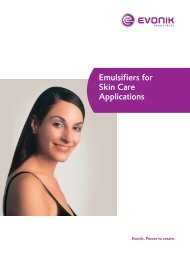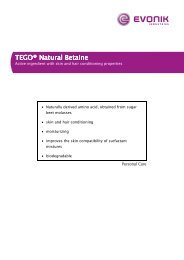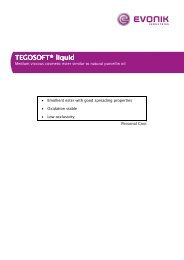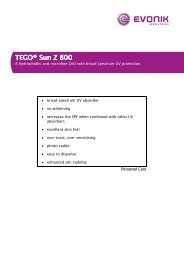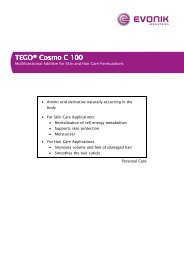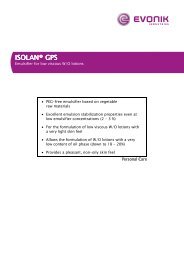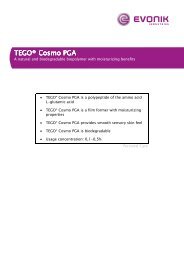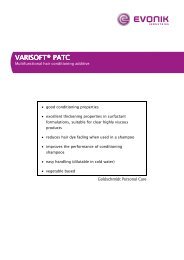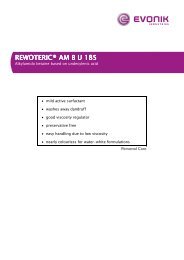SK-influx
SK-influx
SK-influx
You also want an ePaper? Increase the reach of your titles
YUMPU automatically turns print PDFs into web optimized ePapers that Google loves.
INCI Name (CTFA name)<br />
Ceramide 3; Ceramide 6 II; Ceramide 1;<br />
Phytosphingosine; Cholesterol; Sodium Lauroyl<br />
Lactylate; Carbomer; Xanthan Gum<br />
Chemical and physical properties<br />
(not part of specifications)<br />
Form<br />
viscous liquid<br />
Active matter about 2.5 %<br />
Properties<br />
• <strong>SK</strong>-<strong>influx</strong> is a skin-identical lipid concentrate,<br />
which restores the protective barrier function of<br />
the skin.<br />
• <strong>SK</strong>-<strong>influx</strong> is a concentrated formulation,<br />
consisting of a multi-lamellar (membrane) system<br />
resembling the structure of the lipid barrier in the<br />
Stratum Corneum.<br />
• A concentrated mix of different types of<br />
ceramides, cholesterol, free fatty acids and<br />
phytosphingosine makes it an ideal ingredient for<br />
personal care products with unique restoring<br />
capabilities.<br />
• Application of <strong>SK</strong>-<strong>influx</strong> will result in an enhanced<br />
moisturization and protection, ultimately leading<br />
to a less sensitive and less dry skin.<br />
• Depending on the type of skin and desired effect,<br />
<strong>SK</strong>-<strong>influx</strong> is used with concentrations varying<br />
from 1 - 15 %.<br />
However, for typical applications such as ageing<br />
and dry skin a dosage level of 3 - 5 % is<br />
recommended.<br />
System 1: Oil/water with ethoxylated sorbitan<br />
ester<br />
System 2: Oil/water with polyglyceryl ester<br />
System 3: <strong>SK</strong>-<strong>influx</strong> system<br />
Ceramide VI was chosen as a representative<br />
Ceramide for this study.<br />
50 l of each formulation was topically applied to<br />
isolated Stratum Corneum (1.5 cm x 1.5 cm). After 1<br />
hour, excess formulation was removed and new<br />
formulation (50 l) was applied. This was repeated<br />
after the second hour. After 3 hours, excess<br />
formulation was removed from the surface. Ten<br />
layers of Stratum Corneum were removed by<br />
successive stripping with tape. Radioactivity in each<br />
strip was determined by liquid scintillation counting.<br />
The residual Stratum Corneum was excised to<br />
calculate the total amount of Ceramide incorporated<br />
(strips plus residue radioactivity).<br />
Results: The graph shows the amount of Ceramide VI<br />
incorporated in the layers of the Stratum Corneum.<br />
S1-S10 refer to ten sequential tape strips (fig. 1).<br />
Fig. 1: Ex-vivo incorporation study with 14 C-radio<br />
radio-labeled<br />
Ceramide VI<br />
Amount of Ceramide VI (µg)<br />
10<br />
9<br />
8<br />
7<br />
6<br />
5<br />
4<br />
3<br />
2<br />
Oil/water with etoxylated sorbitan ester<br />
Oil/water with polyglyceryl ester<br />
<strong>SK</strong>-<strong>influx</strong><br />
Efficacy studies<br />
Uptake of Ceramide into Stratum Corneum<br />
(Ex-vivo incorporation study)<br />
1<br />
0<br />
s1 s2 s3 s4 s5 s6 s7 s8 s9 s10<br />
Tape strip number<br />
Introduction: This study investigated the extent to<br />
which Ceramides can be incorporated into the<br />
natural lipid barrier of the stratum corneum when<br />
topically applied in different types of formulations.<br />
Study: The study was performed by Prof. P.W. Wertz<br />
at the Dows Institute (University of Iowa, USA).<br />
Methods: 14 C-radiolabeled Ceramide VI was<br />
formulated in three different systems at a<br />
concentration of 0.5 % (specific activity of<br />
59 000 dpm/nmol):<br />
The largest amount of Ceramide VI, thus the best<br />
incorporation, can be found with the <strong>SK</strong>-<strong>influx</strong><br />
system. The lower layers of the Stratum Corneum<br />
showed decreasing amounts of incorporated<br />
Ceramide VI.<br />
Total amounts of incorporated Ceramide VI (strips<br />
plus residue) were 20, 31 and 44 g/cm² for systems<br />
1 to 3 respectively.



